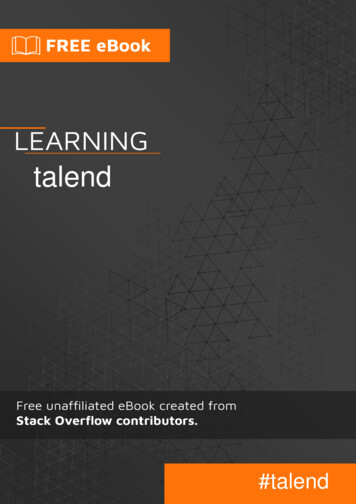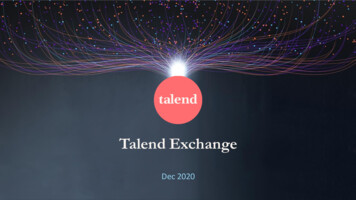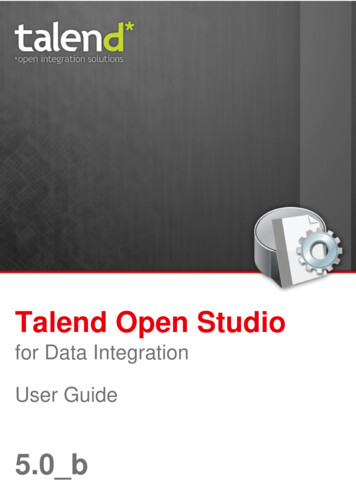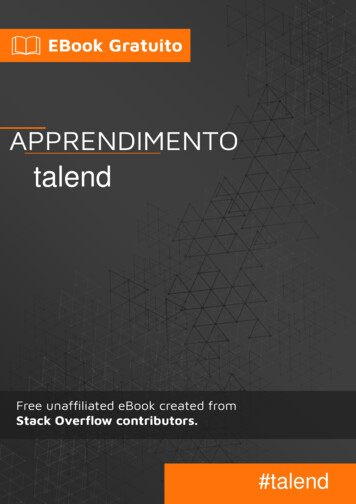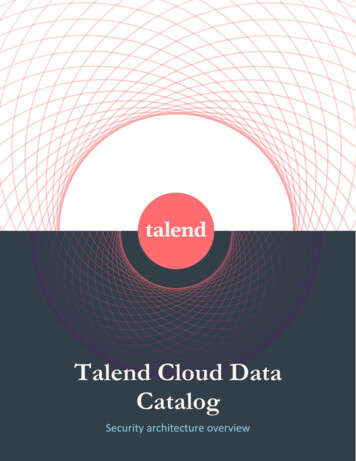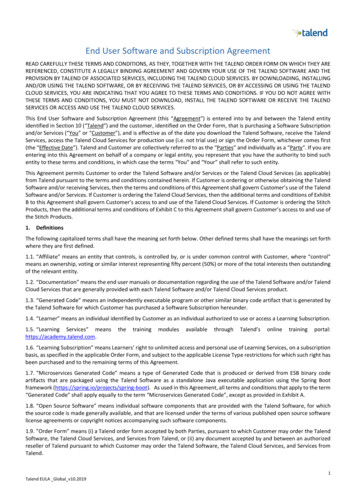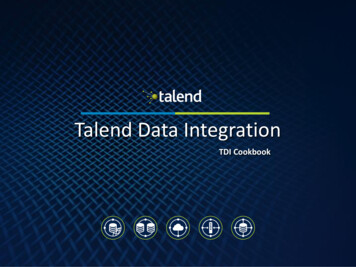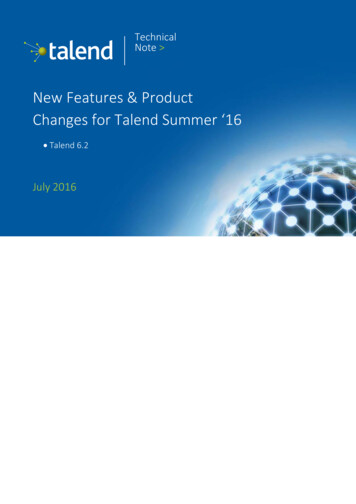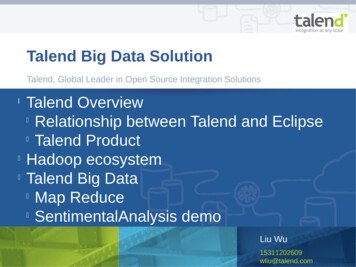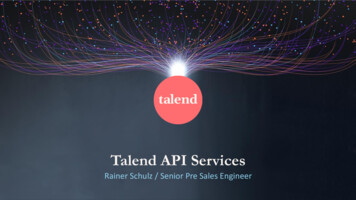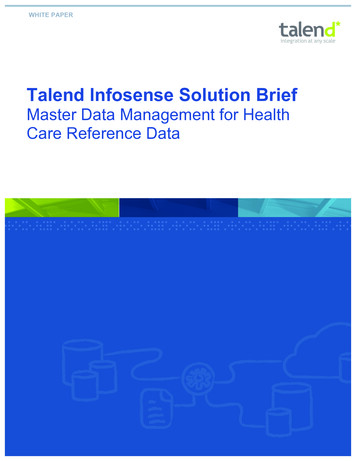
Transcription
WHITE PAPERTalend Infosense Solution BriefMaster Data Management for HealthCare Reference Data
WHITE PAPER Talend Infosense Solution BriefTable of contentsBUSINESS ISSUE: SOCIAL COLLABORATION AND DATASTEWARDSHIP . 5BUSINESS ISSUE: FEEDBACK LOOP AND MORE ACCURATEREPORTING . 6BUSINESS ISSUE: ANALYTICS AND MASTER REFERENCE DATAMANAGEMENT . 7MDM AND RDM DEFINED . 8TALEND, INFOSENSE AND MDM . 9ABOUT TALEND . 10CONTACT INFOSENSE . 102
WHITE PAPER Talend Infosense Solution BriefIn order to effectively serve health care economics, finance, actuarial, and a number ofdepartmental medical informatics business units, data must be integrated. Data managementteams must maintain a variety of data classifications to support a myriad of operationalfunctional areas of a health care organization. Most commonly, these types of solutions areincubated in the form of data repositories, such as analytical data stores, operational datastores, data marts, and data warehouses.Data governance and data stewardship programs are the primary tools to enablingaccountable business and technical staff. In this context, it must be emphasized that controlsand governance must be business steward driven for the classification of data domains. Forinstance: therapeutic drugs health procedure place of service diagnosis provider specialties and types member personas and clustering product / health benefit plans care management activities and programs premium rate setting and reserve setting medical conditions category of services fraud and waste management overpayments/cost containment categories double billing categories national auditsFurthermore, numerous health care data classification is bound to external standardsorganizations such as: CMS, NCQA, AHFS, NDC, AMA, CDC, and third party vendors suchas 3M and HL7.By using external industry standards, most data management teams arealleviated some of the burden to maintain the often cumbersome processes of creating thecomplex world or clinical and health care reference.3
WHITE PAPER Talend Infosense Solution BriefReference Data Management (RDM) solutions are essential to turning the basis of health carereference codification into a human scalable exercise that can be directly plugged into acompany’s data integration or business intelligence functions.As depicted in the following popular clinical data capture and flow, a demonstration of howinitial health care semantics are difficult to manage as ‘coders’ are faced with conversion ofICD-9 to ICD-10. The crux of most of these exercises revolves around having the propercodification at the proper velocity with the right subject matter expertise.This is an exercisebest left to a data steward, or in the case of data classification creation, a data scientist.*H.C. Mullins, MD. ProfessorMaster reference data not only describes the codifications, but also all the objects, attributesand relationships that define the codes in terms of data lineage, business rules, crossreferences, taxonomies, and data stewardship owners.4
WHITE PAPER Talend Infosense Solution BriefBusiness Issue: Social Collaboration andData StewardshipSince ICD-10 implementation, a health care analytics personnel has been requested toprovide a report on high cost patients regarding a descriptive analytics correlated to thehospital standard reporting on medical conditions. The health care analytics personnel havebeen asked to generate this report using data with ICD-9 in the first year and ICD-10 and thesecond year portion of this study.The personnel assigned do not have full expertise in allmedical conditions and must rely on collaboration with specific medical experts.* ICD-10: Roughly 155,000 codes exist in ICD-10-CM and ICD-10-PCS. Only 16,000 codesexist in ICD-9.o Diagnosis ICD-9 Volume 1&2 has 13,000 codes vs. ICD-10 CM, which has 68,000 codes.o Procedure ICD-9 Volume 3 has 3,000 codes vs. ICD-10 PCS, which has 72,000.Ask Yourself: How can a collaborative effort be enabled by use of an easily handled navigation andclassification of 155,000 codifications in ICD-10? How can the specific medical experts deal with their domain of expertise andcollaborate on the rest of the overall conditions jointly? Where can a user determine what type of ICD-10/9 codes are used to group intospecific medical conditions for these high cost claimants? Does the data used in this study support the hospitals medical conditions and specificepisodes of care classification already in place? What risk classifications, data and/or statistical models are used in conjunction withICD-10 for pharmacy, dental, medical, or facility claims in the companies systems? What are the General Equivalence Mappings (GEMS) developed by CMS and NCHSfor ICD-9 and ICD-10 and what specific codifications are needed to resolved theremaining 5% that are not exact matches?RDM provides the answers.5
WHITE PAPER Talend Infosense Solution BriefBusiness Issue: Feedback Loop and moreAccurate ReportingAn employer group, Acme Inc., has requested to investigate ER Outpatient metrics thatappear to be suspicious. The employer group has submitted the request to the insurancepayer’s director of customer analytics. The insurance payer has assigned a business analystto review existing requirements for the metrics determined by classification and rules relateddiagnosis, procedures, and revenue codes. However, the business analysis is not 100% sureif these rules are correct in the system. The business analyst sets up a meeting with theInformation Services (I/S) Department and presents the issues. A technical user is assignedto investigate the programs used to produce this report. The technical user isn’t certain of thebusiness problem and does not fully understand where the data integration programs mightbe wrong. The BA has determined the proper new codes and rules and needs to test therevised metrics.Ask Yourself: What if the business analyst could search and review the data rules in an easy touse form for the data structures, data classification, and rule definitions? How do I/S department’s data integration teams remain proactive and in synch withrequested changes? Do they even need to? Is a self-service solution possible? How can I/S or a BA align with the proper data stewardship owners so that theexperts with the proper knowledge can approve any action items needed whenanalytic results begin to look suspicious? How can customer specific data quality detection issue be corrected quickly andwith minimal or no impact to the system?RDM provides the answers6
WHITE PAPER Talend Infosense Solution BriefBusiness Issue: Analytics and MasterReference Data ManagementNew segmentation of medical conditions has been prescribed by the CMO (Chief MedicalOfficer). A trend study has been ordered to establish the standard metrics for utilization andcost using these new medical condition segments. Health Care Economics has been askedto provide this result using the standard methodologies, but has been asked to use the newdiagnostic categories instead of the currently used categories. The CMO wants to pinpointthe leading indicators of this emerging trend and compare to the previous utilization and costtrends to provide a proposed justification for changing these classifications.Ask Yourself: Current methodologies utilize a combination of diagnosis, hospital room and board,drug, and health procedure codifications to summarize PMPM (per member permonth) utilization and cost under current categories of medical condition. How willthe same methodology be used quickly without rewriting the whole methodology fromscratch? How quickly and cost effectively can the request be satisfied in order to act on theemerging trend and remain proactive? What are the new classifications the CMO has defined? How will these map to the industry standard codes? What data structures will be required to establish the trend results? Who will understand the current methodologies and classifications the best?RDM provides the answers.7
WHITE PAPER Talend Infosense Solution BriefMDM and RDM DefinedMaster Data Management is considered an over arching practice of managing the mostimportant data domains through your organization and across multiple systems in order tocreate an authoritative source. Master Reference Data Management (RDM) can be definedas a specific domain of MDM practice revolving around codes, classifications, and taxonomies.In fact, these data domains may be something different to every organization. It is importantto understand this concept because it will help clarify the business value behind the problemsthat MDM and RDM address. Some of the typical quick MDM and RDM definitions include: Create a single source of the truth Provide proactive data quality Implement process for data Allow cross organization collaboration Enable a data governance strategy Synchronize and aligns systems Improve and enable more accurate reporting Provide stronger ties to analytics and operational intelligenceRegardless of definition, a successful MDM or RDM project will employ several functions inorder to deliver value over time. The typical set of functions includes the following: Profile – Perform regular quality detection assessment on any dataset to detectanomalies and understand data models. Provide insight through user interfaces,reports and data visualization. Integrate – Acquire any data from any source and allow the data to besynchronized and made available in batch or real time and in the right formats tothe systems and users. Standardize – standardize inconsistent data and enrich further. Provide a crossreference and matching including creation of data rules in order accuratelyidentify and survive matching data across and within analytics or transactiondatasets.8
WHITE PAPER Talend Infosense Solution Brief Model & Master – Present intuitive tools to visualize and model any data anddefine relationships among master data. Secure and provision data by user,group or system. Enable any MDM architectural style. Collaborate – Enable a group of users to collaborate on, agree and publish, viaworkflow controls, a set of accepted master reference data.Supply intuitiveaudit tools for manual resolution of data tasks.Talend, Infosense and MDMTalend provides the only master data management solution that delivers easy to deploy, rapid,end-to-end functionality for data integration, data quality, master data, data stewardship andcollaboration workflow of enterprise data in a single solution. The unique, flexible data modelallows organizations to quickly model and master any data domain, not just customers orproducts, and improve access and reliability for both small and large MDM projects. Built onopen standards Talend MDM is an open source solution available in two editions.TalendOpen Studio for MDM allows for implementation of a complete MDM project or can help todevelop an MDM strategy or pilot. It is provided under the GPL license and can bedownloaded from talend.com. Talend Platform for MDM contains all the functionality of theTalend Open Studio for MDM and adds advanced features for workflow, multiple users, largerscalability and hierarchy management, amongst others. It is being used by organizations of allsizes to accomplish their master customer data goals.Infosense provides the only Talend implementation of a reference data management platformplug-in for analytics and business intelligence reporting for health care organizations. TheInfosense/Talend solution provides a reference data model-driven approach using TalendPlatform for MDM, data management and health care industry data model. Infosense offersindustry health care data model accelerators that are easily coupled with technology platformspecific data integration, data quality, and reference data solutions. These tools and datamodels provide a very compelling and proactive mechanism for collaborative datastewardship between IT and business consumer groups.9
WHITE PAPER Talend Infosense Solution BriefAbout TalendTalend is one of the largest pure play vendors of open source software, offering a breadth ofmiddleware solutions that address both data management and application integration needs.Since the emergence of data integration and data quality tools in the 1990s, and the morerecent appearance of Master Data Management solutions, the data management market hasbeen dominated by a small - and quickly consolidating - number of traditional vendors offeringproprietary, closed solutions, which only the largest and wealthiest organizations can afford.The situation in the application integration space is quite similar, with significant consolidationoccurring as well. As a result, only a minority of organizations use commercial solutions tomeet their data management and application integration needs. Indeed, these solutions notonly demand a steep initial investment, but they also often require significant resources tomanage implementation and ongoing operation.Contact UsContact info goes @talend.comsales@talend.comContact focents10 Talend 2013WP171-EN
audit tools for manual resolution of data tasks. Talend, Infosense and MDM Talend provides the only master data management solution that delivers easy to deploy, rapid, end-to-end functionality for data integration, data quality, master data, data stewardship and collaboration workflow
